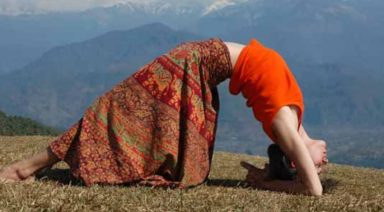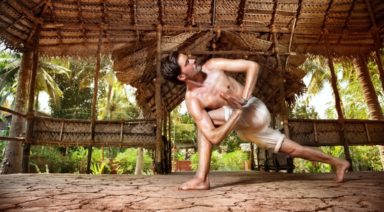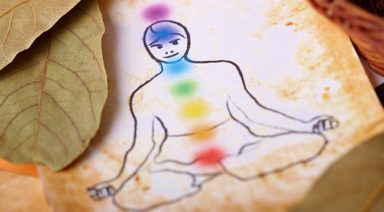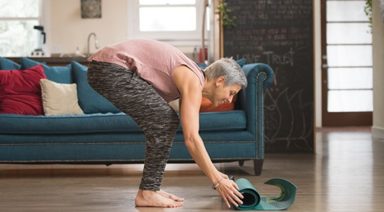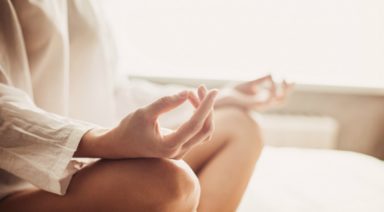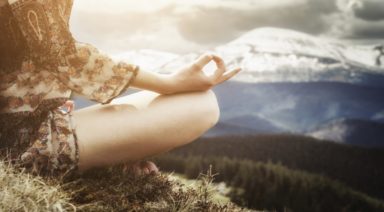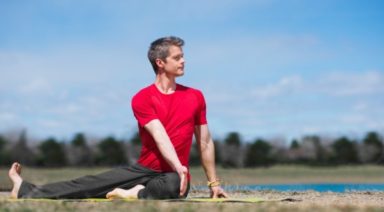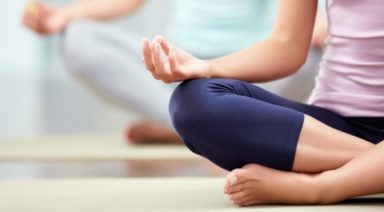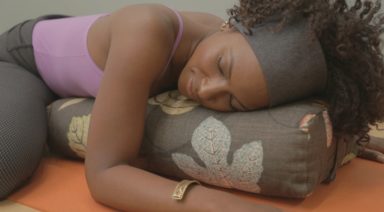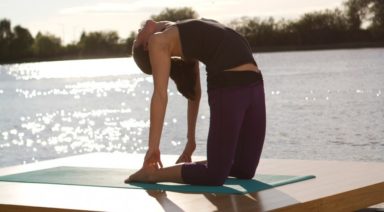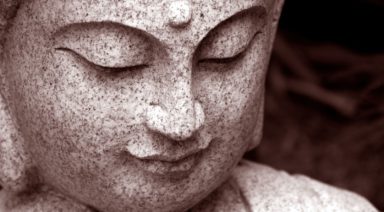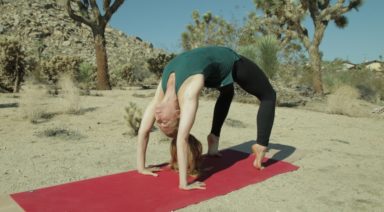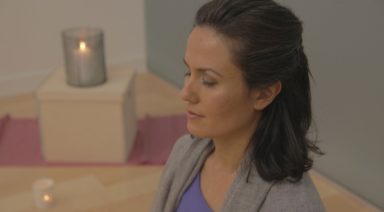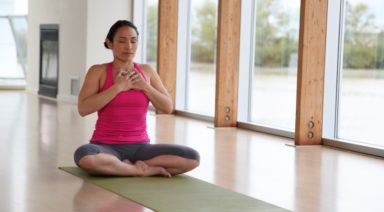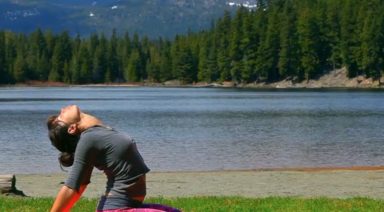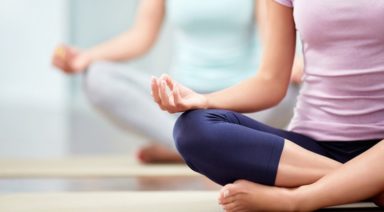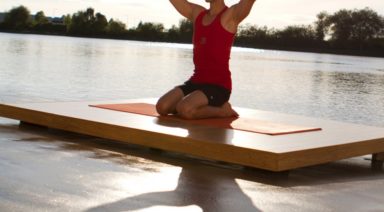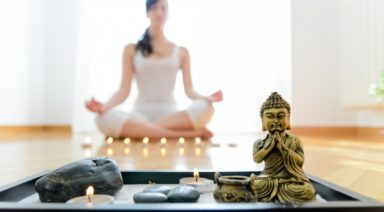How to Balance Your Solar Plexus Chakra
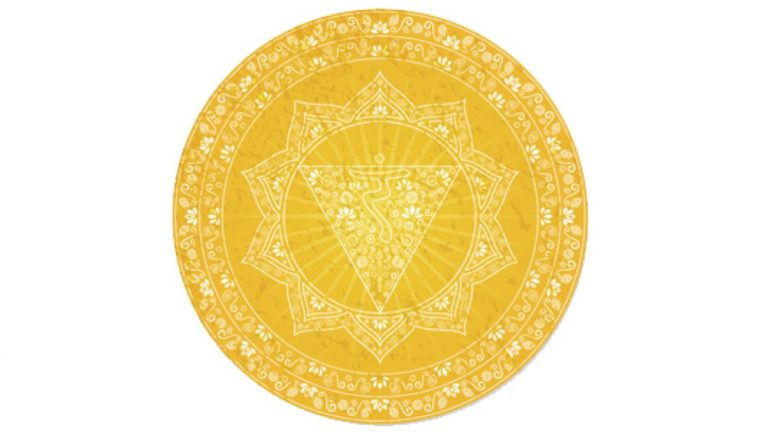
The Solar Plexus chakra or Manipura chakra is often referred to as the chakra of personal power. Located two inches above the navel at the base of the rib cage, it is the seat of our ego and where we draw motivation to achieve our goals. It governs our ability to achieve the goals we set for ourselves, moderates our self-esteem, it oversees our raw emotions and we draw on it for our self-discipline.
Call on Your Solar Plexus Chakra to Understand Your Emotional Self
When our Solar Plexus is unbalanced we experience both physical and emotional problems. Because this chakra is located near the abdomen, it affects many internal organs such as the kidneys, intestines and pancreas. Stomach ulcers and possible weight problems can also be attributed to an unbalanced Solar Plexus. In addition, we may suffer from back problems, lethargy and because this chakra is connected to our sense of sight, we may experience blurriness with our vision.
Note that physical ailments have a dramatic effect on our emotional and spiritual state and that if we pay attention to these energies within our bodies, we could, in earnest, take control of illnesses we feel are wreaking havoc on our bodies.
If it is under-active, it can lead to emotional problems, sometimes seriously. We may feel powerless or ineffective which can lead to negative thoughts and despair, we will doubt ourselves and our accomplishments and see mistrust within our friends and family. Anxiety and low self-esteem often accompany an under-active Solar Plexus and if we let these emotions fester, it can and will affect our other chakras, and by extension, our physical and emotional states.
Yet a Solar Plexus that is overactive can be just as harmful. Too much of a good thing, no matter how healthy or helpful it is, never good for us. If we find ourselves judging people too harshly or have become too critical or demanding, then our Solar Plexus could be over-stimulating our system. Anger and aggressiveness is another symptom of this overactive chakra. Anger is one of the more serious effects as it has a noted physical reaction. When we are angry the body re-directs blood away from the abdomen area and to the muscles in preparation for a physical confrontation, therefore, starving the organs of the Solar Plexus of nutrients.
How Anger Affects the Body
When the energy of our Solar Plexus is balanced, our outlook on life improves, criticisms and problems are easier to handle, and you have control over your emotions and your thoughts. The ego is easier to handle. You will understand and accept your inner peace and radiate that acceptance outward, coming to appreciate people and things around you. When balanced, our Solar Plexus gives us confidence in ourselves and our performance. We feel accomplished and proud of our work and achieving our goals. We create an emotional focal point.
The Solar Plexus Chakra is connected to the sense of sight. It is thought that nearsighted people may an over-abundance of fear or insecurity, while those who are far-sighted hold unresolved anger or guilt. We can draw on our personal power to help stimulate the chakra. Exercising our self-discipline not only brings us closer to our goals, but strengthens our chakra and allows us to digest the more unfavorable situations and negativity in our lives.
See the Solar Plexus Light at the End of the Tunnel
Stimulating the Solar Plexus is as easy as taking a walk and observing a sunset or sunrise. Visit a park or just watch the stars. Observing the many colors in our world can stimulate and reinforce more than one Chakra point.
Color is an important part of Chakra therapy. Just like sound vibrations, each color has a corresponding wavelength.
A simple way to fortify or help keep your chakras balanced is to wear clothing or an item of the corresponding chakra color. Try this exercise: as you go about your day, periodically think about the color you’re wearing. Imagine that color infusing into the corresponding chakra point. See it in your mind, blending with your body, soaking into your skin. Take several deep breaths, exhaling all the air out of your lungs. Do this several times a day, or when you happen to remember. It will go a long way in helping you to condition your mind to balance your energies.
You can also try the meditation exercise above with any of the colors below to balance their respective chakras:
- Red/black for the Root
- Orange for the Sacral
- Yellow for the Solar Plexus
- Green for the Heart
- Blue for the Throat
- Indigo for the Third Eye
- Violet for the Crown
How to Balance Your Solar Plexus
There are as many different ways to balance our chakras as there are people in the world, and what works for one person may not work for another. Some people like to sit and meditate, using sounds and smells to relax and re-energize, while others may chose exercise or participating in other activities that stimulate our points. Whichever way you chose, make sure that it’s right for you. If you feel uncomfortable doing a yoga position, try listening to music and focusing on how your body responds, or if you are more energetic, a good hike or riding a bike might be better suited. This is the important part; listen to your body. It will tell you what works and what doesn’t.
To nourish your spiritual side, try volunteering or taking a class; learn something new. This nourishes our mind and spirit.
Solar Plexus Balancing Tools
Crystals
Stones of yellow hue are best to use. Crystals such as amber, citrine, golden or honey calcite, yellow sapphire are just a few. Wear or place these crystals on your body as you listen to meditative music, or carry them in your pocket.
Sound
Using sound as part of your chakra balancing is a soothing and relaxing way to release the tension and blockage within our bodies. Either by ‘toning’ which is using a specific vowel sound, drawing it out in a tone of voice you feel comfortable using. For the Solar Plexus, the sound of ‘oh’ should be used.
A Bijas mantra is different and can be used as well. The Bijas for the Solar Plexus is RAM.
New Experiences
The Solar Plexus helps with mental clarity as well as learning new things. Try taking up a new hobby or playing games that stimulate and sharpens your mind. These are excellent ways to keep this chakra open and balanced.
While the majority of these suggestions concentrate with feeding our emotional and mental side, we need to think of our body as well. Keeping the body healthy with the right food and good exercise can also keep the chakras balanced and the energy flowing. Consider eating foods that are yellow, such as some squash, yellow bell peppers and lemons. Fruits and vegetables of this color contain antioxidants such as lutein. Research suggests that lutein along with other plant basted antioxidants, may reduce the risk of chronic eye disease.
Yoga Poses to Balance the Solar Plexus
Stimulate and balance your solar plexus with full yoga classes or individual poses, listed below.
Yoga Classes on Gaia
- Third Chakra Yoga Practice
- The Healing Elements: Fire: The Third Chakra
- Authentic Power: Enlivening the Third Chakra
Yoga Poses
- Boat
- Firefly
- Mountain
- Warrior pose I
- Warrior pose II
Vernal Equinox: Ritual Through Yoga

Over the course of each year, our playful planet performs an elliptic dance around the sun while simultaneously spinning about its own imperfect axis, which tilts roughly 23 degrees from vertical. Born of the primordial fire, the terms of this intricate cosmic relationship are responsible for all of the natural rhythms that inform our daily lives — from changing weather patterns to reliable zeitgebers that regulate our internal clocks.
When one tugs at a single thing in nature, he finds it attached to the rest of the world.
::John Muir
The Story of a Blue Sphere and a Fiery Mass
As Earth diligently revolves around the sun each year, there are four distinct sandhis, or junctures, where a clear seasonal shift occurs from our terrestrial perspective. The vernal equinox is one such juncture, marking the transition from winter to spring.
As we welcome the appearance of new life in nature, many of us remain blissfully unaware. We may neglect or even override the innate curiosity that seeks to understand how our cozy blue sphere and its fiery solar star orchestrate this magnificent show year after year. The truth is, when it comes to their relationship status, “it’s complicated.”
A Practical Approach to Visualization
Imagine yourself sitting in a camping chair with your feet warmed by the heat of a well-burning fire. Fortunately, you’re equipped with a warm scarf and hat to dull the chill you might otherwise experience as you recline back (at exactly 23.4°) to enjoy the stars. Now, without adjusting the direction your chair is facing, imagine yourself orbiting around the focal fire to the opposite side, giving the back of your head a chance to enjoy the warmth of the flame.
If your feet were the southern hemisphere and your head where the northern hemisphere, these two positions would represent the winter solstice (with more heat reaching the bottom half of your body) and the summer solstice (with more heat reaching the top half of your body) respectively.
To visualize the vernal equinox, imagine your chair was to revolve just a quarter of the way around this campfire circle. In this position, your body would be leaning neither toward nor away from the fire and the projected plane of your navel (the equator of your body) might pass directly through the center of the glow. Also, the light reaching one side of your body would match the darkness on the opposite side, much like the day and night which are of approximately equal length on the equinox.
Still confused? Don’t sweat it, simply allow yourself to enjoy the fruits of spring with a deep knowing that there are some wildly wonderful forces at play.
Emergence of the Exhale
Played out on a living, organic sphere, the seasons are guided by a unique planetary breath rhythm. The annual breath of the Earth, much like our own cyclical respiration, serves the purpose of bringing nutrients into the system in exchange for that which cannot be utilized. During the Vernal Equinox, our sleepy planet awakens from the depth of its winter inhalation and begins a 6-month out-breath.
Lean into the Light
Illustrated in the table above, the vernal equinox is a point of orbital balance marking the emergence of days that outlive nights as the axis of the planet bows once again, toward the sun. In direct response to increasingly available sunlight, a life that remained dormant in the barren winter months begins to awaken in receipt of new light. All of nature comes to life — hibernating creatures wake up with healthy appetites and germinating plants shed the shackles of their seeds.
“For a seed to achieve its greatest expression, it must come completely undone. The shell cracks, its insides come out and everything changes. To someone who doesn’t understand growth, it would look like complete destruction.” ::Cynthia Occelli
Subtle Body Spring: Melting the Inner Snow
As nature begins to melt the winter snow in spring, rivers and far-reaching tributaries swell with freshwater that sustains the natural environment as well as human communities. Mirroring the wisdom of the planet, now is the time to water any seeds of intention we may have planted at the beginning of the year and evaluate which future crops and creative projects we will irrigate with the melt of our inner snow.
Just as mountain rivers are swelling their waters, our bodies respond in much the same way at this time of year. This is nature’s way of melting the inner “snow” of the body.
::Shiva Rea, Tending the Heart Fire
Recalibrating Rhythm
Like a bear emerging from the deep sleep of hibernation, sometimes it can be difficult to recalibrate the body and mind for the vibrant spring rhythm. During the long period of seasonal darkness that precedes the vernal equinox, the body naturally increases melatonin production, a hormone that promotes the desire for sleep. This is the planet’s way of encouraging us to slow down and regenerate during fall and winter.
However, with the advent of smartphones and 24/7 connectivity, we override many of these environmental signals which can disrupt our natural circadian rhythms. This dissonance may leave energy levels, which were supposed to have been replenished during the winter, somewhat depleted when springtime arrives.
Fortunately, the daily increase in sunlight that occurs during this half of the year, has its own subtle body effects which include an increase in the mood-elevating hormone, serotonin as well as testosterone and estrogen.
While the shift in our internal chemistry generally increases energy and vitality, this period of hormonal recalibration puts a strain on the endocrine system which can leave us feeling a little tired as we meet the seasonal transition. To navigate the changing internal landscape, any effort to cleanse and detoxify the body can help alleviate energetic stagnation in preparation for the luminous spring ahead.
The Kappa Season
The predominant dosha during springtime is kappa, comprising earth and water. With heavy rains and warming temperatures, the elemental density and heaviness of kappa in late winter continues into spring. As we approach the equinox, it becomes necessary to balance these kappa qualities in order to alleviate winter-induced inertia and energetic malaise. The ideal rhythm for springtime is kappa-pacifying: meet the cool, oily, and heavy qualities of earth and water with the arid warmth and lightness of air and fire.
- Lighten Up. The vernal equinox welcomes a thorough spring cleaning, in our homes and in our hearts. Start by addressing any clutter that has accumulated during the winter and dispose of it in a meaningful way. In your home, this might be as simple as donating articles of clothing or re-purposing a piece of furniture. In your heart, you might tune into the presence of any heavy emotions, assimilate what you can learn from, and let the rest dissolve. Write in a journal to rid your subtle body of excess energetic weight and to create space for what is to come. Only once you have cleared any obstructions, can you begin a deep clean.
- Cleanse. Since kappa is able to sustain with or without food, enjoy a short fast or cleanse during the spring season using astringent fruit juices or warming, spiced kitchari. To stimulate the digestive fire before meals, try chewing on a small slice of fresh ginger. Shed layers of winter skin by dry-brushing before bathing and minimize the use of body oils. If you find yourself battling allergies with spring fever, consider cleansing the nasal passages with nasya, herb-infused oil, to facilitate the clear exchange of Prana. Alternatively, this can be done with warm salt water using a neti pot.
- Nourish. Concentrate on slow, mindful meal times so that your body experiences maximum satiety to avoid overeating or emotionally driven consumption which are symptoms of excess kappa. Favor light foods that are easy to digest with pungent, bitter, and astringent tastes. Foods like apples, pears, brussels sprouts, cabbage, and carrots for instance. Avoid heavy, oily foods with sweet, salty and sour tastes which increase kappa.
Invigorating Yoga Practices for the Spring Equinox
To bring balance to the gunas (attributes) of the kappa season, we emerge from the regenerative practice of the cold winter months and transition into the increased energy and mobility of spring. As we adapt to the seasonal rhythm, the most beneficial physical practices are those that enliven vira rasa. The term rasa can be used to define the intrinsic energetic quality or essence of being and vira is a word for hero. Vira rasa is the embodiment of potency and courage which are reinforced by an active, solar practice. This particular movement alchemy is appropriate for any time when we are experiencing a cycle of growth and renewal.
- Summon Your Strength — Enjoy arm balances and core cultivation as well as heating inversions to experiment with a new strength that has developed from the fortifying rest of winter.
- Clear Congestion — Relieve physical and emotional congestion by practicing dynamic postures with a vigorous pace before exploring strong, standing hip-openers, and activation. This can mobilize stagnant earth and water elements that may have accumulated here through winter.
- Burn Bright — Experience the ardent internal cleansing of heat-inducing pranayama such as kapalabhati, bhastrika and surya bhedana.
- Detoxify — Any process of purification requires a great heat. In the same way that steam can disinfect the surfaces in your home, internal heat and massage can assist the body’s natural metabolic processes which rid the system of toxins and purify the cells while reducing inflammation. Focus on postures that stimulate the circulatory, digestive and lymphatic systems like bound twists and activating backbends.
Spring Equinox Sequence: Moving Meditation for the Whole Body
Heart
Tap into your innermost virya, meaning vitality, enthusiasm, and effort, with focus and attention. Maintain an affirmative inner dialogue and embody the heart of a warrior. Either internally or aloud, invoke the mantra of supreme light with reverence to the sun, our absolute source of sustenance. Allow this to be a mantra of purification and release as you move toward internal balance.
OM HRIM HAMSA SO’HAM SWAHA
om: the primordial sound of the universe, the vibration of all creation, the guru
hrim: bija, seed sound for clarity and dispelling illusion, mantra for the cosmic light, the sun
hamsa so’ham: the balance of light and dark, sun and moon, Shiva and Shakti, the power of the breath for bringing vitality
swaha: let it be so, dedication to the light
*translations by David Frawley
Breath
During this stimulating practice, focus on powerful ujjayi breathing to circulate a steady supply of oxygen through the blood. Maintain a strong, audible breathing rhythm through the nostrils, releasing heat through the mouth on the exhale as needed. With this victorious yogic breath, internal body heat increases as does the circulation of Prana.
Body
This practice is a pilgrimage to Natarajasana that alchemizes twisting and backbends to open the channels of the spine and create space in the body. Beginning with an energizing kriya, we employ the breath to heat and polish the body from the inside out. What follows is a series of progressive twisting namaskars to energize and open before diving into standing backbends. The practice will close with deep-seated hip openers to alleviate emotional congestion before releasing into final relaxation.
To support your self-practice, please refer to the pose breakdown below with links to photos and alignment for each posture or enjoy the complete guided sequence video.





